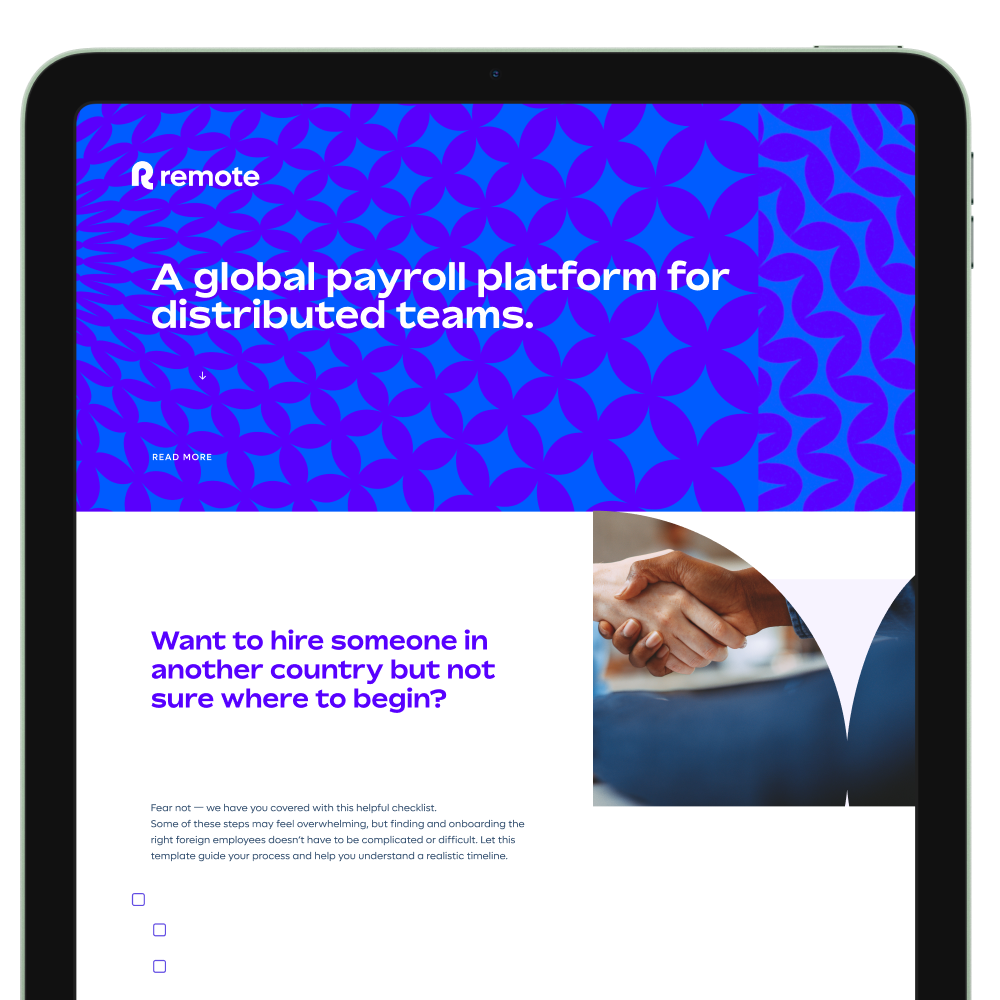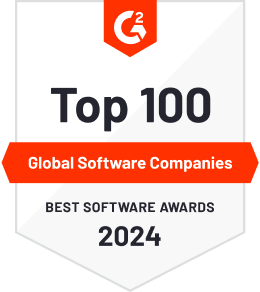
Product Updates — 7 min

Employer of Record & PEO — 8 min
Your company’s human resources (HR) workload can be taxing — especially if you’re running a small or mid-sized business or launching a startup.
You might wish you could just find someone else to deal with the hard parts of HR.
There are various HR platforms and partners available to help you streamline HR processes. A professional employer organization (PEO) is an option that you can consider if your company owns a local legal entity. If you’re hiring internationally, an employer of record (EOR) is the ideal solution to simplify the challenges of global HR.
But before you hurry to Google to find the nearest PEO, take some time to learn more about what services a PEO does (and doesn’t) provide.
This article explains the ins and outs of PEOs. And for businesses looking at expanding internationally, we’ll also cover whether you should consider working with an EOR instead.
So let’s unpack the details of PEOs and look at practical HR solutions that will give you peace of mind.
Think of a PEO as an outsourced HR department.
Complex administrative HR tasks can steal so much time from small- and medium-sized businesses. As a company expands, admin personnel may not have time to keep up with the increased workload themselves.
To remedy that, a business might outsource difficult HR and payroll work to a PEO.
As an example, there are between 700 and 1,000 PEO companies operating in the US. These companies handle things like payroll, employee benefits, taxes, and certain types of compliance documentation for businesses.
Not only do they ensure your employees get paid, but the best providers can manage time off requests and tax forms, among other things.
If you are considering PEO services, Sequoia One offer a comprehensive solution that combines seamlessly with the power of Remote's HR software platform.
It’s easy to confuse the two, but there’s a major difference between these two types of business services.
A payroll company or payroll service provider takes care of your company’s payroll administration and makes sure you’re compliant with local tax laws.
A PEO offers that same payroll and compliance assistance in addition to taking care of other HR services.
We’ll look at PEO services in more detail in a moment. But first, let’s answer the question of how a PEO works.
PEOs operate under a co-employment model.
A co-employment arrangement is a contractual relationship in which a company and a PEO share certain employment responsibilities that would otherwise be handled only by the company's internal HR team.
When you partner with a PEO, both you and the PEO share responsibility for employing your workers. Your employees continue working for you as usual, while the PEO handles back-office employer tasks like payroll, benefits, and compliance.
However, it’s different if you use an EOR for HR outsourcing in a foreign country.
Even though some in the HR industry use the terms interchangeably, PEOs and EORs are not the same.
An EOR acts as the legal employer. This means that, technically, your employees work for the EOR (for compliance reasons). But in practice, they work for you, the same as any of your other employees.
This can be a preferable option for companies that have compliance obligations in multiple countries. As the legal employer, the EOR takes on the burden of staying up to date with all relevant local legal and taxation obligations, allowing companies to avoid the complexity and time involved with these HR challenges.
Larger organizations may have the financial resources to manage the complexities of global HR on their own, but smaller businesses often don’t.
PEOs take on a number of these employer responsibilities. By outsourcing to a PEO, companies that struggle with the day-to-day work of employee administration can provide a better experience for their teams in a variety of ways, such as the following:
Nothing can doom a promising company like unhappy employees who don’t get paid on time.
PEOs provide reliable payroll services so that company leaders don’t have to stress about the details of deposits, bank accounts, and paperwork.
Most PEOs provide self-service options to employees, too, so workers can update their information and change their preferences on their own. This feature can greatly reduce friction and exposure to risk for the business.
Different companies offer different employee benefits, but most benefits fall into the same basic categories of insurance, time off, reimbursements, etc.
PEOs can handle even the most unusual benefits of their client companies, so don’t be afraid to reach out if you aren’t sure whether your PEO can help.
In addition, PEOs usually have access to broader benefits networks than employers can find on their own. This can help companies access health insurance with more coverage and better rates, plus retirement plans with lower fees and more investment options for employees.
With remote work becoming more common, more companies now have employees in multiple parts of the world.
Business owners need a full EOR to hire international workers, but if you have employees in certain locations, a PEO can ensure you don’t run into tax troubles.
For example, if you're based in the US, you no longer need to worry about proper withholding rates for federal and state taxes, or about making your payroll tax payments on time. A PEO can handle that on your behalf.
Tax compliance makes up a large part of a PEO’s responsibility, but taxes aren’t the only form of compliance small businesses must follow. There are other reporting requirements, too.
Not only do you have to file the proper documentation to classify your workers as employees or contractors, but you must also make sure you comply with local regulations relating to workers’ compensation, social responsibility programs such as unemployment, and other country-specific rules.
Misclassifying workers carries serious consequences, so if you aren’t sure whether you’re following the law, you may want to get some outside help.
PEOs don’t usually offer auditing services to double-check employee classification, but they do ensure you don’t get in trouble for filing the paperwork incorrectly.
Small- and medium-sized businesses may save money and hassle by leaning on a PEO to do the heavy HR lifting and take on a number of administrative functions.
As mentioned earlier, companies working with PEOs usually get access to a wider variety of insurance and financial products than the same companies could on their own.
Because PEOs work with several businesses at once, they can spread risk across a larger pool of employees, making them more appealing to underwriters than small businesses with only a few dozen employees.
Companies may also find it easier to scale more quickly when working with a PEO as opposed to keeping all HR tasks in-house. The more people you hire, the more time you must take to onboard workers and the more internal resources you must dedicate to providing a good experience for your teams.
With a PEO, you can streamline your HR operations and improve consistency across payroll, benefits, and compliance.
While a PEO helps support compliance with employment laws, it’s important to remember that you, as the employer, still hold ultimate responsibility. By offloading many time-consuming administrative tasks, a PEO enables you and your team to focus more on driving business growth and less on day-to-day HR details.
Work through this checklist to help you stay compliant when you're employing across borders.

Now let’s talk about expanding internationally and hiring foreign employees. That’s where EORs come in.
Businesses looking to expand internationally typically face a choice. One option is to establish themselves physically in other countries by setting up international entities. This can require considerable time and money, and is usually better suited to large, multinational businesses.
The alternative is to hire foreign team members through an EOR. Like a PEO, an EOR is a third-party organization that handles the legal and administrative responsibilities associated with employing personnel on behalf of their client.
The key difference is that EORs employ through their own legal entities in foreign countries. A good EOR partner should be intimately familiar with relevant HR procedures and labor laws in those countries.
An EOR should also manage key employment tasks on their customer’s behalf, such as hiring, payroll, tax compliance, benefits administration, and the maintenance of employment records.
This option is usually often faster, safer, and more cost-effective than opening a legal entity in multiple countries.
To be clear: if you’re expanding abroad but don’t establish an international entity in your new market, you can’t work with a PEO. This is because the co-employment relationship of a PEO requires a local entity on your company's part. In situations such as this, an EOR is an ideal alternative.
To find out more about the differences between PEOs and EORs, take a look at our in-depth guide: Does your business need an EOR or a PEO?
And if you’re looking to hire someone in another country and don’t have a local entity there, find out when you should use an EOR — and how to choose one that’s right for your business.
If you’re a small or medium-sized business owner that needs HR help, teaming up with a PEO is definitely worth considering. But if you want to expand your business internationally, an EOR may give you more flexibility.
Luckily, Remote offers the best of both worlds. We provide dedicated global payroll and global HRIS services, allowing you to easily manage your people across the globe.
We also offer EOR services, enabling you to focus on expansion without worrying about administration and compliance issues.
Whatever your global HR needs, Remote has you covered, helping you to stay ahead of the competition and unlock new opportunities for growth.
If you’re unsure which approach is the right one for your business and you want to learn more — including how Remote can help — come and speak to one of our friendly experts today.
Create an account with G2's top-ranked multi-country payroll software and start onboarding your first employees in minutes.

Subscribe to receive the latest
Remote blog posts and updates in your inbox.

Product Updates — 7 min

Global Payroll — 2 min

Minimum Wage & Compensation — 7 min

Newsroom — 5 min